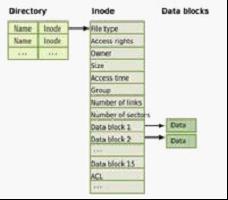Data Recovery -> EXT3
Storage devices
Types of HDD
Partition Series
Linux
Operating Systems
Windows
EXT3
 Ext2 is a kind of journal file system. It is the expansion of ext2 system. It is compatible with ext2. The advantage of journal file system is: as the operation is with the cache layer, if it is not being used, it has to discharge the file system to wirte the information of cache layer back to the disc. Therefore whenever the system is turning off, it has to shut down all the file systems. If the system is turned off before all the file systems are shut down (for example power cut), the next time you turn on the system, you will find the inconformity of file system informations. So it is time to reform the file system and repair the inconformity and error. However, the reformation is extremely time-taking, especially the large capacity file system. And it is not sure that all the information will not be lost.
Ext2 is a kind of journal file system. It is the expansion of ext2 system. It is compatible with ext2. The advantage of journal file system is: as the operation is with the cache layer, if it is not being used, it has to discharge the file system to wirte the information of cache layer back to the disc. Therefore whenever the system is turning off, it has to shut down all the file systems. If the system is turned off before all the file systems are shut down (for example power cut), the next time you turn on the system, you will find the inconformity of file system informations. So it is time to reform the file system and repair the inconformity and error. However, the reformation is extremely time-taking, especially the large capacity file system. And it is not sure that all the information will not be lost. The biggest feature of this kind of file system is that it will record the whole write-in movement of disc so that it is convenient to trace back if it is in need. At the same time MiniTool Partition Wizard can help the ext2 and ext3 to manage the partition file system. Because that informations write-in includes many details such as changing the head information of files, searching for the writable space of disc, writing in the information sector one by one, etc, if any detail is interrupted half way, it will cause the inconformity of file system. Nevertheless, in the journal system, if the process is interrupted, the system can trace back and reform the interrupted part. There is no need to spend the time to examnine other parts. The speed of reformation is rather fast.
Features
1. High Applicability
If the system uses ext3 file system, even after the improper shut down, it needn't examination of file system. After the downtime of system, it only need a few ten seconds to recovery.
2. Integrity of Data
Ext3 file system can promote the integrity of file system to a large extent. It avoids the damage of accidental downtime. To keep the integrity of data, ext3 file system has two modes for you to choose. One is "keep the consistency of file system and data" mode. Choosing this mode you will never find the junk files after improper shutdown.
3. The Speed of File System
Although when you are using ext3 file system, it needs to repeatedly write in when saving data, but in general ext3 is better than ext2. That is because the journal function of ext3 has optimized the read-write head of disc driver. Therefore read-write performance of file system has not dropped.
4. Data Conversion
Ext2 file system can be easily converted to ext3 file system. It only needs two simple orders to complete the conversion. The users need no time to back up, recover, and format the partition. Use the small tool tune2fs provided by ext3file system, it can easily convert ext2 file system to ext3 journal file system. In addition, ext3 file system can be directly loaded to convert to ext2 file system without any changes.
5. Multi-journal Modes
Ext3 has various journal modes. One working mode is to record all the file data and metadata (the data of definition file system data, the data of data) (data=journal mode.). Another working mode is to record the metadata, and not to record data. That is data=ordered or data=writeback mode. The system manager can choose between the speed or the consistency of file data according to the practical work requirement of system.
Ext3 Overview
Developer: open source
Full name: Third extended file system
Release time: November, 2001 (Linux 2.4.15)
Partition identification: 0x83 (MBR);EBD0A0A2-B9E5-4433-87C0-68B6B72699C7 (GPT)
Ext3 Structure
Directory: list, tree
File allocation: bitmap (clear area), list (metadata)
Bad block: list
Limitation
The largest file: 16GiB-64TiB
The greatest file number: changeable
The longest file name: 255bytes
The largest volume: 2TiB-32TiB
The allowed characters: all the bytes except NUL or "/"
Function
Record date: mtime, ctime, atime
Date limit: December 14, 1901- January 18, 2038
Date resolution: 1 second
Fork: yes
Attributes: No-atime, append-only, synchronous-write, no-dump, h-tree (directory), immutable, journal, secure-delete, top (directory), allow-undelete
Accesss right: Unix permission, ACLs and arbitrary security attributes (Linux 2.6 and later)
Transparent compression: no
Transparent encryption: no (block device level provided)
Support operating system: Linux, BSD, and Windows (through IFS)